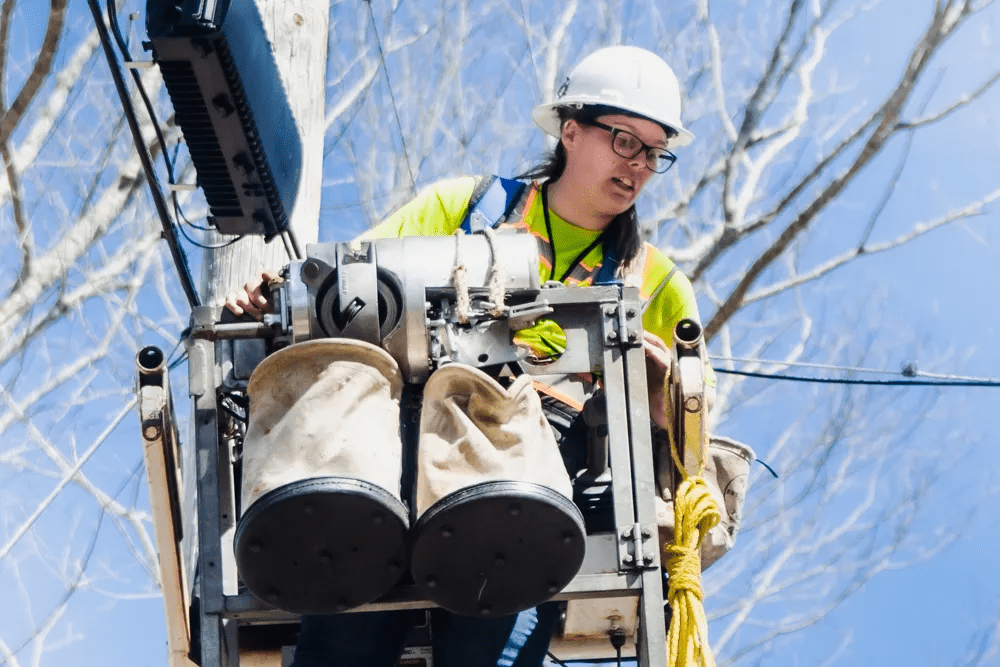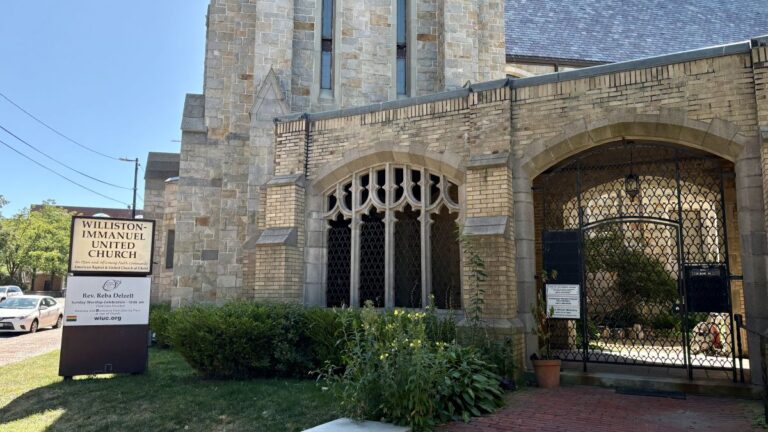Amber Richards stands in an aerial lift truck in the canopy of trees on Georgetown Island off the midcoast of Maine. She steps onto the basket’s side rails, lifts the 50-pound cable lasher, and places it on the cable line.
A member of the line crew watches from below, explaining her maneuver.
“The buckets are made for guys,” the lineman says. “Women often need to step up to the side rails to reach the cable. It makes it harder, but Amber makes it look easy.”
About 30 miles west at an intersection in downtown Lewiston, Heidi Leighton, Hawkeye Fiber Optics’ most recent hire, is in another bucket learning how to splice cable to an existing strand.
“OK, now wrap it back,” the lineman calls from the street.
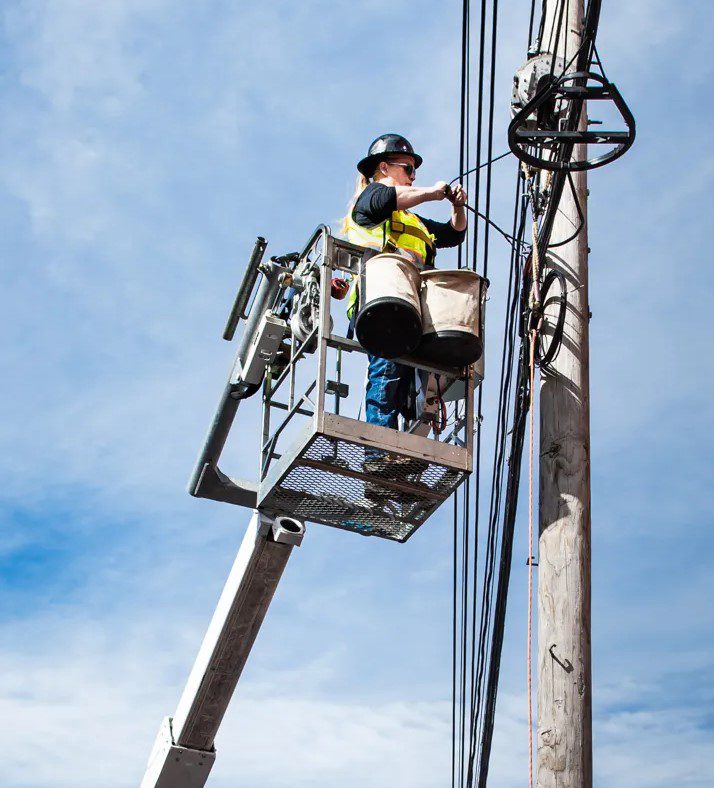
After the run of cable is complete, Leighton exclaims, “I was nervous, scared, shaky, and excited all at the same time.”
In a field traditionally dominated by men, Richards and Leighton are joining a growing number of women in rural Maine becoming part of fiber-optic cable line crews.
With unprecedented federal funding for broadband infrastructure, regional companies like Hawkeye Fiber Optics struggle to provide the workforce needed to land large contracts.
In a recent Maine Broadband Workforce Strategy report, experts predicted the state’s fiber broadband workforce is short hundreds of positions needed to install fiber-optic cable in some of the most rugged regions of America.
A recent report from The Wall Street Journal stated that “at the current pace of hiring, the U.S. broadband workforce of some 478,000 won’t be enough to meet the government’s timeline.”
That workforce gap, according to Kwame Yeboah, Maine Connectivity Authority’s workforce development manager, is presenting a huge challenge for local, Maine-based ISPs.
“The large ISPs, like Charter, bring people from as far away as Florida,” Yeboah told the Daily Yonder. “If they have a team in New York, they just ship the whole team to the next location, house them, then they ship them back.”
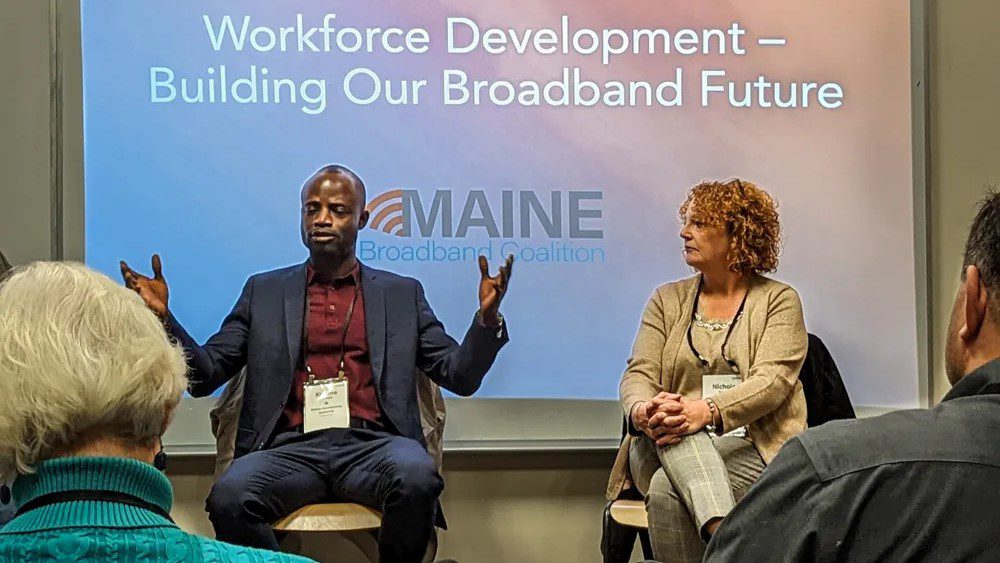
To address these workforce shortages, Danae Wilson, assistant director for internet access at the White House Office of Science and Technology Policy, offered alternatives to traditional hiring methods, inviting ISPs to develop a strong local workshop by tapping into “invisible” labor markets.
“There are opportunities readily available at your fingertips, but they might not come through your normal realm,” Wilson said in a public presentation at the Maine Broadband Summit in March 2023. “They might be veterans, young people, people who’ve been incarcerated, and women who never imagined themselves in this male-dominated field.”
Wages must remain competitive, Wilson said, even while other industries like fast-food are increasing pay levels.
“You’ll see people with skills that are meant for fiber installation but can go work at a fast-food restaurant because they’re able to get $17 an hour,” she said. “When you start out in this field, especially as an apprentice, those aren’t the typical starting salaries.”
She emphasized the importance of enticing workers by providing incentives and benefits.
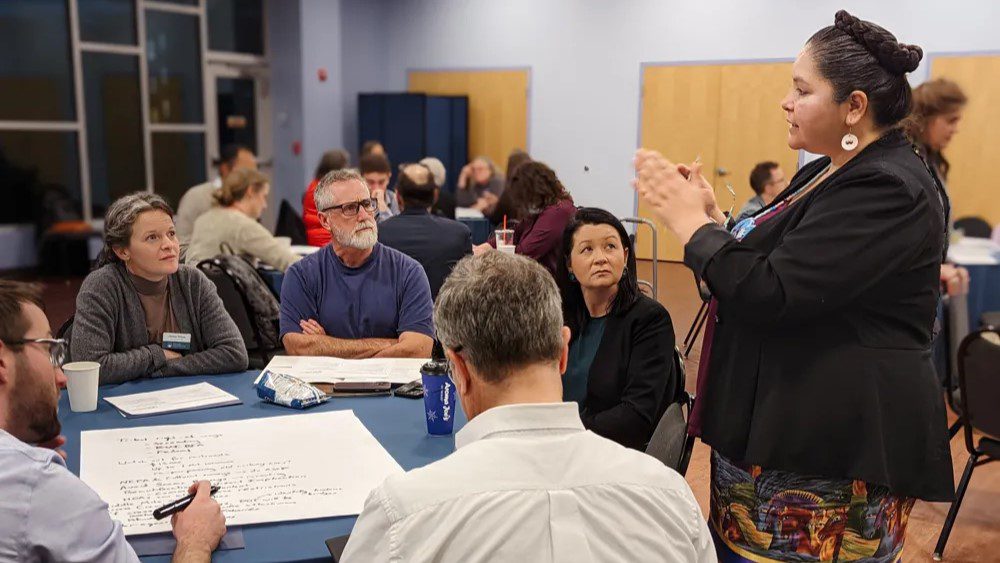
The founder of Hawkeye Fiber, Ryan Hawkes, agreed.
“As a Maine-based company, we are doing everything possible to build a local workforce,” Hawkes told the Daily Yonder. “We don’t want to bring in outside help. It muddies the waters of what Mainers can do for ourselves. But if we don’t stay competitive, they’re going to give funding to someone who can.”
To grow his workforce, he offers on-the-job training and competitive pay. Entry-level workers with zero experience start at $17 an hour. Experienced line workers can start upwards of $40 an hour. Hawke is proud of the package he offers his employees.
“We’ve got a $9,000 to $12,000 a year benefits package. If you add that on to a or $36,000 a year salary, you’re still in that $20 an hour mark, at our lowest position. As they grow in experience, the money’s there.”
In a state where rural women can earn less than $28,000 year, according to Maine Center for Economic Policy, some women see fiber optic installation as a path to a better life.
At 27, Richards is a single mom of three kids under the age of 10. She’s proud of her rapid progress toward becoming a lineman.
“I started as a flagger,” she told the Daily Yonder. “It took eight months to become a ground hand.”
The work has paid off.
“Being a groundman has changed all aspects of my life,” she said. “Financially, I’m the most stable I’ve ever been. I’m working towards being able to give my kids the life they truly deserve. Plus, here I have a voice. It feels good to have my opinion and suggestions valued and heard.”
When Leighton first started working at Hawkeye as a flagger, Hawke asked her what her goals were.
“I wanted a house for my kids. I wanted a vehicle to get back and forth to work, and I wanted my two front teeth fixed. This winter I was able to pay all my bills, my heat stayed on, and my cupboards were filled.”
And she’s reaching other goals, too. “In three months my last dream will come true. I will get my teeth fixed. It’s been a haul. There were days when I didn’t know if I could make it. But I love showing myself that I can do anything I set out to do. Each day I prove to myself, I can do anything they (men) can do, sometimes better.”
Nearly one out of seven members of the Hawkeye Fiber Optics line crew is a woman. Hawke said that’s not a surprise.
“I grew up with four sisters, so I know that girls can do anything guys can do and usually better.”


